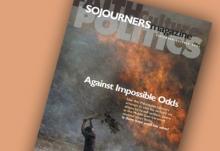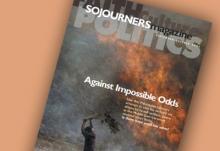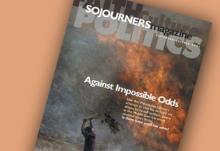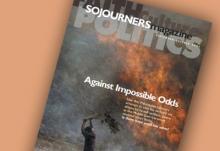I was moved by Josh Healey's concern for the human rights of Palestinians ("Not in My Name"). It's encouraging to see young people committed to justice.
Middle East
When this book was published, the Committee to Protect Journalists had just named the West Bank as "the worst place to be a journalist."
First he took off his hat and coat; then his sweater and shirt.
This edition of Sojourners went to press just as the U.S. military strikes in Afghanistan began, which makes this special issue even more critical.

You wouldn't know it from media reports, but there's a hopeful movement being born in the Middle East
My wife, Joy, my son, Luke, and I had dinner recently with our friend Michael Lerner and his wife, Debora, in their Berkeley, California home.
What we are able to remember is important, but how we remember is even more so. Nowhere is this more true than in the Middle East.
A young Israeli soldier kicks a small rubber ball to two Palestinian boys in the West Bank city of Hebron, his machine gun slapping gently against his back as he moves. His fellow soldiers smoke and play cards nearby. Men in long flowing robes and white headscarves pass boys riding donkeys, tiny Palestinian shops loaded with film and souvenirs, and stores whose doorways are filled with bulging sacks of colored spices and grains.
Just beyond the soldiers sits an immense, foreboding building—one of its two entrances is guarded by Palestinian soldiers, the other by Israelis. It’s called the Mosque of Abraham or the Tomb of the Patriarchs, depending on who’s speaking, and inside are massive stones marking the supposed burial sites of Abraham and Sarah. Concrete walls enclose the tombstones. Muslims and Jews can view them through a set of iron bars, but only from separated parts of the building. The structure was bisected in 1994 after a Jewish settler, an American, entered the building and killed 49 Palestinians preparing to celebrate the Muslim holy month of Ramadan.
The Israeli soldiers are also in Hebron, a Palestinian-controlled city of about 140,000, to guard Jewish settlers who live down the street in a compound distinctive for its brand-new buildings and the barbed wire that surrounds it. "Five hundred soldiers are here to guard 30 settler families," according to Bourke Kennedy, a member of the Christian Peacemaker Team in Hebron. The Jewish settlement is one of four in the Hebron district; roughly 6,000 Jewish settlers live in two settlements on the city’s outskirts. Because of their political and symbolic importance, settlements such as these have been targets—and impetus—for Hamas and other Palestinian groups who have resisted the Israeli occupation with violence.



